
The Curran Theatre, located at 445 Geary Street between Taylor and Mason Streets in the Theatre District of San Francisco, California opened in February 1922, and was named after its first owner, Homer Curran. As of 2014, the theater is owned by Carole Shorenstein Hays.

The Majestic Theatre is a Broadway theater at 245 West 44th Street in the Theater District of Midtown Manhattan in New York City. Opened in 1927, the theater was designed by Herbert J. Krapp in a Spanish style and was built for real-estate developer Irwin S. Chanin. It has 1,681 seats across two levels and is operated by The Shubert Organization. Both the facade and interior are New York City landmarks.

The Marcus Performing Arts Center, originally the Performing Arts Center, is a performing arts center in Milwaukee, Wisconsin, United States. Managed by a non-profit organization, it is marketed as Milwaukee's premier presenter of the performing arts. It is located at 929 North Water Street, at the intersection of State Street in downtown Milwaukee, and is a dedicated War Memorial.
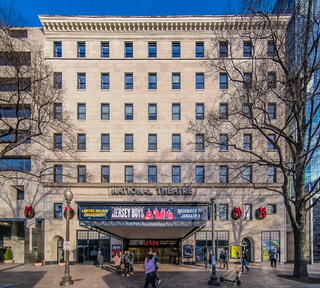
The National Theatre in the United States is located in downtown Washington, D.C., just east of the White House, and functions as a venue for live stage productions with seating for 1,676. Despite its name, it is not a governmentally funded national theatre, but operated by a private, non-profit organization.

The Auditorium Theatre is a music and performance venue located in the Auditorium Building at 50 E. Ida B. Wells Drive in Chicago, Illinois. Inspired by the Richardsonian Romanesque Style of architect Henry Hobson Richardson, the building was designed by Dankmar Adler and Louis Sullivan and completed in 1889. The Chicago Symphony Orchestra performed in the theatre until 1904 as well as the Chicago Grand Opera Company and its successors the Chicago Opera Association and Chicago Civic Opera until its relocation to the Civic Opera House in 1929. The theater was home to the Joffrey Ballet from 1998 until 2020. It currently hosts a variety of concerts, musicals, performances, and events. Since the 1940s, it has been owned by Roosevelt University and since the 1960s it has been refurbished and managed by an independent non-profit arts organization.

Orpheum Theatre is a theater located in downtown Minneapolis, Minnesota. It is one of four restored theaters on Hennepin Avenue, along with the Pantages Theatre, the State Theatre and the Shubert Theatre.

The performing arts community in Louisville, Kentucky is undergoing a renaissance. The Kentucky Center, dedicated in 1983, located in the downtown hotel and entertainment district, is a premiere performing arts center. It features a variety of plays and concerts, and is the performance home of the Louisville Ballet, Louisville Orchestra, Broadway Across America - Louisville, Music Theatre Louisville, Stage One, KentuckyShow! and the Kentucky Opera, which is the twelfth oldest opera in the United States. The center also manages the historic W. L. Lyons Brown Theatre, which opened in 1925 and is patterned after New York's acclaimed Music Box Theatre.

Martin Marietta Center for the Performing Arts is the premier location for cultural arts and entertainment in Raleigh, North Carolina. The center consists of four unique venues, Raleigh Memorial Auditorium, Meymandi Concert Hall, A.J. Fletcher Opera Theater, and Kennedy Theatre.

The Orpheum Theatre, a 2,308-seat venue listed on the National Register of Historic Places, is located in downtown Memphis, Tennessee, on the southwest corner of the intersection of South Main and Beale streets. The Orpheum, along with the Halloran Centre for Performing Arts & Education, compose the Orpheum Theatre Group, a community-supported nonprofit corporation that operates and maintains the venues and presents education programs.
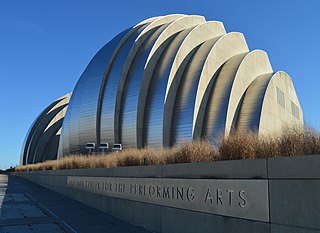
The Kauffman Center for the Performing Arts is in downtown Kansas City, Missouri, USA, at 16th and Broadway, near the city's Power & Light District, the T-Mobile Center and the Crossroads Arts District. Opened in 2011, it houses two venues: the 1,800-seat Muriel Kauffman Theatre, home of the Kansas City Ballet and Lyric Opera of Kansas City; and the 1,600-seat Helzberg Hall, home of the Kansas City Symphony Orchestra. Both venues host a variety of artists and performance groups in addition to these three resident entities.
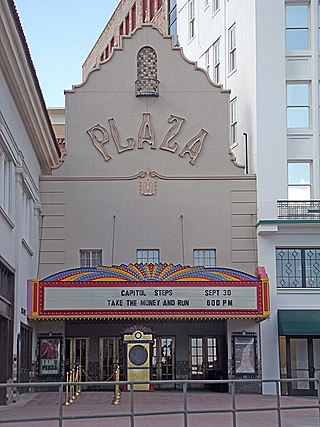
The Plaza Theatre is a historic building in El Paso, Texas built in 1930. The theater stands as one of the city's most well-known landmarks, and remains operational today. The theatre is a National Historic Building of Significance featuring the 2,050-seat Kendall Kidd Performance Hall, and the smaller 200-seat Philanthropy Theatre. It hosts Broadway productions, musical concerts, individual performers and the annual Plaza Classic Film Festival.

The Springer Opera House is a historic theater at 103 Tenth Street in Downtown Columbus, Georgia. First opened February 21, 1871, the theater was named the State Theatre of Georgia by Governor Jimmy Carter for its 100th anniversary season, a designation made permanent by the 1992 state legislature. The Springer has hosted legendary performers such as Edwin Booth, Oscar Wilde, Ethel Barrymore, Agnes de Mille, and bandleader John Philip Sousa. The building was added to the National Register of Historic Places in 1970 and named a National Historic Landmark in 1978 for its architecture and state of preservation.

The Benjamin & Marian Schuster Performing Arts Center is located in Dayton, Ohio and was built in 2003 to serve as Dayton's principal center of the lively arts. It is owned and operated by Dayton Live and occupies the former site of Rike's department store on a block comprising North Main Street, West Second Street and North Ludlow Street. It is named for local philanthropists Dr. And Mrs. Benjamin Schuster who donated the lead gift for the project.

The Majestic Theatre is a performing arts theater in the City Center District of Downtown Dallas. It is the last remnant of Theater Row, the city's historic entertainment center on Elm Street, and is a contributing property in the Harwood Street Historic District. The structure is a Dallas Landmark and is listed on the National Register of Historic Places.

The Joe R. and Teresa Lozano Long Center for the Performing Arts is a performing arts venue located along Lady Bird Lake in downtown Austin, Texas. The Long Center is the permanent home of the Austin Symphony Orchestra, Austin Opera and Ballet Austin and hosts other Austin-area performing arts organizations.

The Palace Theatre is a music venue in downtown Louisville, Kentucky, located in the city's theater district, on the east side of Fourth Street, between Broadway and Chestnut Street. It has a seating capacity of 2,800 people and is owned by Live Nation. The historic landmark opened on September 1, 1928, and was designed by architect John Eberson. It was originally known as the Loew's and United Artists State theatre.
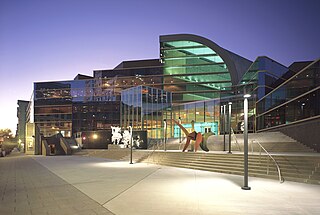
The Kentucky Center for the Performing Arts in Louisville, Kentucky, which opened in 1983, is owned by Kentucky Performing Arts and has tenants that include Kentucky Opera, Louisville Ballet, the Louisville Orchestra, StageOne Family Theatre and Broadway Across America. Sculptural artwork at the site is by Alexander Calder, Joan Miró, John Chamberlain, Jean Dubuffet and others.

The Bronx Opera House is a former theater, part of the Subway Circuit, now converted into a boutique hotel in the Melrose neighborhood of the Bronx, New York City. It was designed by George M. Keister and built in 1913 at 436 East 149th Street on the site of Frederick Schnaufer's stable. It was one of several theaters to come into the area that became known as the Hub. It was formally dedicated on opening night Saturday, August 30, 1913.

The Burton Cummings Theatre is a theatre located in Winnipeg, Manitoba, Canada. Built by local impresario Corliss Powers Walker, it was originally known as the Walker Theatre. The building was renamed after singer-songwriter and Winnipeg native Burton Cummings in 2002.
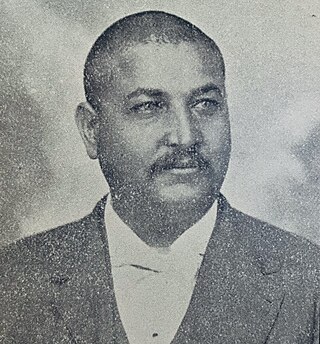
Henry A. Tandy was an American building contractor and entrepreneur, specializing in decorative stone masonry and brickwork. Of African-American descent, he was born enslaved in Estill County, Kentucky, and rose to become one of the wealthiest African Americans in Kentucky by the early twentieth century. His best-known commission is the historic Fayette County Courthouse in Lexington, Kentucky (1898–1900). In 2020, the downtown Cheapside Park, which is adjacent to the courthouse, was renamed the Henry A. Tandy Centennial Park in his honor.




















